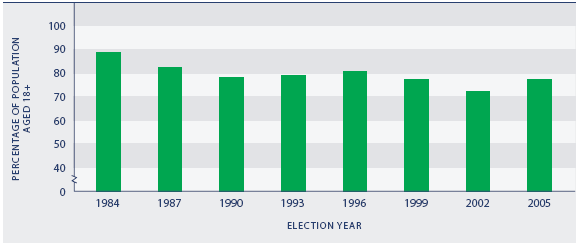Voter turnout
Definition
General elections: The proportion of the estimated voting-age population (aged 18 years and over) who cast a vote in general elections.
Local authority elections: The proportion of all enrolled electors (both resident and ratepayer) who cast a vote in contested local authority elections.
Relevance
Voter turnout rates are an indicator of the extent to which citizens participate in the political process, and the confidence the population has in, and the importance they attach to, political institutions.
Current level and trends
1. General elections
Voter turnout of the eligible population in 2005 was 77 percent. Voter participation in general elections declined sharply from 89 percent in 1984 to 78 percent in 1990, increased slightly to 81 percent in 1996, then declined again to a new low of 72.5 percent in 2002. In 2005, the turnout recovered to the level recorded in the 1999 election.
Figure CP1.1 Proportion of estimated voting-age population who cast votes, 1984–2005

Sources: Electoral Commission (2002); Electoral Commission (2005)
Note: 1984 and 2005 figures calculated by the Ministry of Social Development
Age, sex, ethnic and socio-economic differences
Because of the nature of the secret ballot, information on differences in participation rates among various sectors of the New Zealand population is not directly available. Nevertheless, results from New Zealand election surveys over a number of years show non-voters are more likely to be people on lower incomes, younger people and members of Māori or Pacific ethnic groups. There are few differences in voter turnout rates between men and women.
Regional differences
There are few discernible differences in voter turnout rates between rural and urban voters, although non-voting tends to be lowest in provincial cities.
International comparison
Using a different definition of voter turnout (the proportion of the registered population who voted), New Zealand was ranked eighth out of 30 OECD countries with a voter turnout rate of 81 percent in 2005.69 The New Zealand rate was higher than the OECD median of 71 percent for recent elections, but lower than that of Australia, where voting is compulsory (92 percent in 2004). Countries with lower voter turnout rates than New Zealand included Canada (65 percent in 2006), the United Kingdom (62 percent in 2005), and the United States (60 percent in 2004).
Current level and trends
2. Local authority elections
Voter turnout in the 2004 local authority elections was 46 percent. This was the lowest turnout since 1989 and the first time since then that overall turnout has fallen below 50 percent. A major restructuring of local government in 1989 was initially accompanied by a noticeable increase in voter turnout, peaking at 61 percent in 1992. Voter turnout has declined steadily since then, with the exception of the 1998 elections.
The drop in turnout between 2001 and 2004 was relatively constant across all types of local authorities. However, district councils registered the greatest decline, with the average turnout dropping from 57 percent in 2001 to 51 percent in 2004.
In 2004, there were 251 elected local authorities in New Zealand : 12 regional councils, 21 district health boards, 16 city councils, 58 district councils and 144 community boards.
Table CP1.1 Voter turnout (%) in local authority elections, 1989–2004
| |
1989 |
1992 |
1995 |
1998 |
2001 |
2004 |
| Regional councils |
56 |
52 |
48 |
53 |
49 |
45 |
| District health boards |
– |
– |
– |
– |
50 |
46 |
| Territorial authorities |
|
|
|
|
|
|
| City councils |
52 |
48 |
49 |
51 |
45 |
43 |
| City mayors |
50 |
48 |
49 |
51 |
45 |
43 |
| District councils |
67 |
61 |
59 |
61 |
57 |
51 |
| District mayors |
67 |
61 |
59 |
59 |
56 |
52 |
| Community boards |
54 |
49 |
50 |
50 |
46 |
42 |
Source: Department of Internal Affairs (2006) Table 3.3
Note: DHBs were established in 2001
The 2004 election results continued the trend of previous local authority elections, with small and South Island communities tending to register a higher voter turnout across all election types. The highest voter turnout in regional council elections was for the West Coast Regional Council (68 percent), followed by the Otago and Southland regional councils (each 56 percent). In all but two North Island regions less than half the population voted. The exceptions were Manawatu-Whanganui (54 percent) and Taranaki (55 percent). The regional council with the lowest voter turnout was Auckland (42 percent).
Local authority voter turnout is highest for district councils, with their more rural population base, especially those in the South Island. In the 2004 district council elections, turnout in the South Island was 57 percent, compared with 50 percent in the North Island. Smaller regional councils and small district health boards also attracted a higher turnout than larger local authorities. Voter turnout ranged from 58 percent for small district councils to 42 percent for large city councils. |

